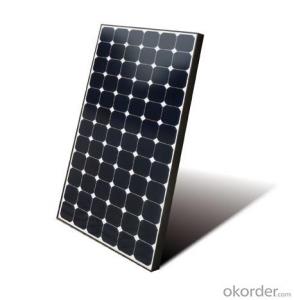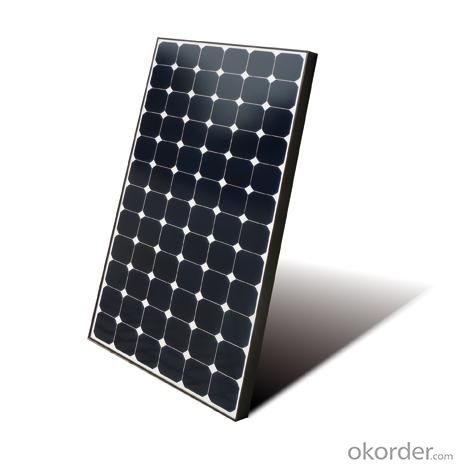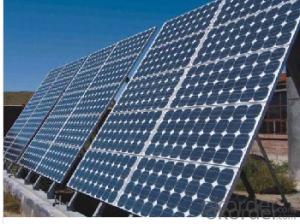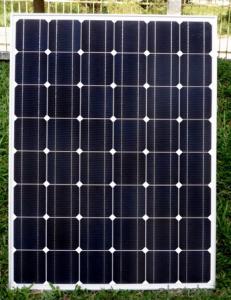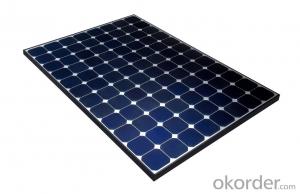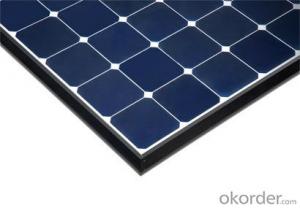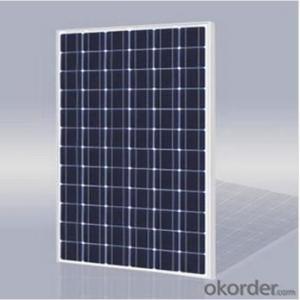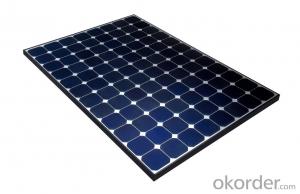Best Solar Panels 2024:CNBM Poly Solar Panel 265W A Grade with Factory Price
- Loading Port:
- Shanghai
- Payment Terms:
- TT OR LC
- Min Order Qty:
- 100 watt
- Supply Capability:
- 100000 watt/month
OKorder Service Pledge
OKorder Financial Service
You Might Also Like
Specification
CNBM Poly Solar Panel 265W A Grade with Factory Price
Production description
A solar panel is a collection of solar cells. Lots of small solar cells spread over a large area can work together to provide enough power to be useful. The more light that hits a cell, the more electricity it produces, so spacecraft are usually designed with solar panels that can always be pointed at the Sun even as the rest of the body of the spacecraft moves around, much as a tank turret can be aimed independently of where the tank is going.
Each module is rated by its DC output power under standard test conditions, and typically ranges from 100 to 365 watts. The efficiency of a module determines the area of a module given the same rated output – an 8% efficient 230 watt module will have twice the area of a 16% efficient 230 watt module.
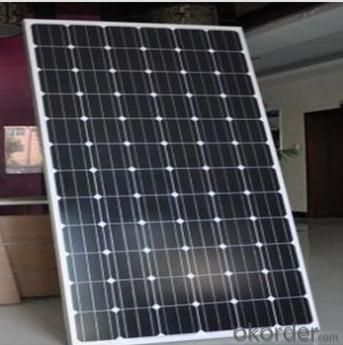
Application
Aerospace
Residential
Commercial
Large solar power plant
Distributed plant
Product Feature
1.A grade high efficiency solar cells.
2.TUV/UL/CE/CEC etc
3.Fast shippment
4.25 years warranty
5.OEM
Package
24pcs into one carton, 312pcs into a 20 foot container, 728pcs into a 40 foot container.
- Q: What Are Solar Panels Made Of?
- Silicon, simular to aluminum foil. When assembled correctly will produce electricity. This is a prosition process to construct. Check out DIY sites on the internet. I hope this was helpful?
- Q: I really would like to have my own solar panel, but i don't know how. Most of the panels i have looked at are for car batteries but i'm not sure how this would be able to be transfered into electricity. I'm looking to power things like lamps, a stereo and various chargers for phones and ipods. Please explain to me how i could adapt a solar panel to my uses. Thank you.
- Sounds okorder .. I've seen the particular device listed there. While the lamp is mediocre for an LED light source, the panel is excellent - real polysilicon wafers, in an aluminum frame. Same construction as the kind of panels in commercial installations.
- Q: i dont wanna buy a solar panel becuase its too exspensive, i dont want use technical stuff i want to use every day materiels, but i need to know asap plzzzz.
- I'm afraid you can't just make a solar panel with things just laying around the house. They require some specialized materials and techniques to create. Just buy what you need.
- Q: Can solar panels be used to power a farm?
- Yes, solar panels can be used to power a farm. By harnessing the power of the sun, solar panels can generate electricity that can be used to run various farm operations such as irrigation systems, grain dryers, electric fencing, and even power agricultural machinery. This renewable energy source not only reduces reliance on fossil fuels but also helps farmers save on energy costs while promoting sustainability.
- Q: looking for alternative ways to save energy money and thinking about solar panels. anyone know anything about it and how expensive it is to install them?
- One okorder to save people a tremendous amount of money on solar installs.
- Q: I have a cabin in the woods and need more light. I do have enough sun but I was wondering how or where do I get a solar panel to lead to a power outlet? In a perfect world I would like to get a solar panel with a connecting wire to an outlet or something so I could power a small TV. I know its hard enough but can I get that pre-made? Or even lastly should I look at wind power consider I would like this to be under $500? Thank you for putting up with this bundle of questions.
- A typical solar panel will deliver 50 watts of power in the form of 24 volts DC. You need 20 volts AC. So here is what it takes: Since you will need at least 200 watts to do a small TV, you need four solar panels, and a solar controller. Then you need a 24 volt solar type battery to load the output of the panels. Next you need an inverter. This is a device that changes 24 volts DC into 20 volts AC, which you can wire to a standard outlet for the TV set. Solar panels cost around $6 per watt of power. 200 X $6 = $200 Solar Controller will cost around $50 The battery will cost around $00 The inverter will cost around $200 You could get by with less than 200 watts of solar panels if you just let it charge the battery all day and only use the TV for an hour or two in the evening with the TV running on the inverter which is powered by the battery. The link is for a similar system ready to go. Wind is not a viable option.
- Q: I'm going to this camp and the instructors asked us to be prepared tomorrow to build a sun tracker for a solar panel. Does any one have any ideas, tips, or advice?
- Since the sun moves in the sky on a very predicatable course you don't need a closed loop control system to track it. All you need is a clock-drive motor and the proper gearing for your latitude. The clock drive motor will move at a constant rotational velocity based on time, and when it is geared down properly the angle of the shaft will follow the sun. Make sure the clock motor is powerful enough to move the solar panel, etc. That's a start, anyway. .
- Q: I riped two solar panels out of some solar light and tested them. I found out that they both produce 2 volts(I have no idea on the watts or amps). Iquot;ve hooked them up to an electric motor that can be driven by a AA battery, but when I hook the solar panels up to them nothing happens. What is wrong?
- to do basic electrical experiments with solar panels and motors, it is necessary to have a digital volt-amp-ohm meter sometimes called a DVM (digital volt meter). What is the voltage that the solar panels give when the motor is not connected? what is the voltage when the motor is connected? If the motor resistance is too low, then the solar panels will not be able to supply enough current to run the motor and the voltage with the motor attached will be very low. It might take a bright light on the solar panels or direct sunlight.
- Q: Can solar panels be used for powering agricultural equipment?
- Yes, solar panels can be used for powering agricultural equipment. Solar energy can be converted into electricity, which can then be used to power various agricultural machinery and equipment such as pumps, irrigation systems, electric fences, and even small tractors. This helps reduce reliance on traditional fossil fuels, promotes sustainable farming practices, and can save farmers money in the long run.
- Q: China is building solar panels and have been for years. That is the most abundant energy in the world. My nieghbor has two panels on his roof and he actually sells energy back to the electric company. These panels cost about $30,000. each, because we don't produce them here on that level.If we did, that price would drop drastically. Other alternatives are also available. Drilling for oil will no change anything. Once you give the oil companie the go ahead, the will focus on that and the alternatives won't be developed any farther. We will be right back here in about 0 years. The price will not go down anyway. So why not switch half of our fuel to alternatives?
- I visit hundreds of houses a week in my line of work and there are houses in neighborhoods that aren't the wealthiest that have solar. It might be cheaper than you think.
Send your message to us
Best Solar Panels 2024:CNBM Poly Solar Panel 265W A Grade with Factory Price
- Loading Port:
- Shanghai
- Payment Terms:
- TT OR LC
- Min Order Qty:
- 100 watt
- Supply Capability:
- 100000 watt/month
OKorder Service Pledge
OKorder Financial Service
Similar products
Hot products
Hot Searches
